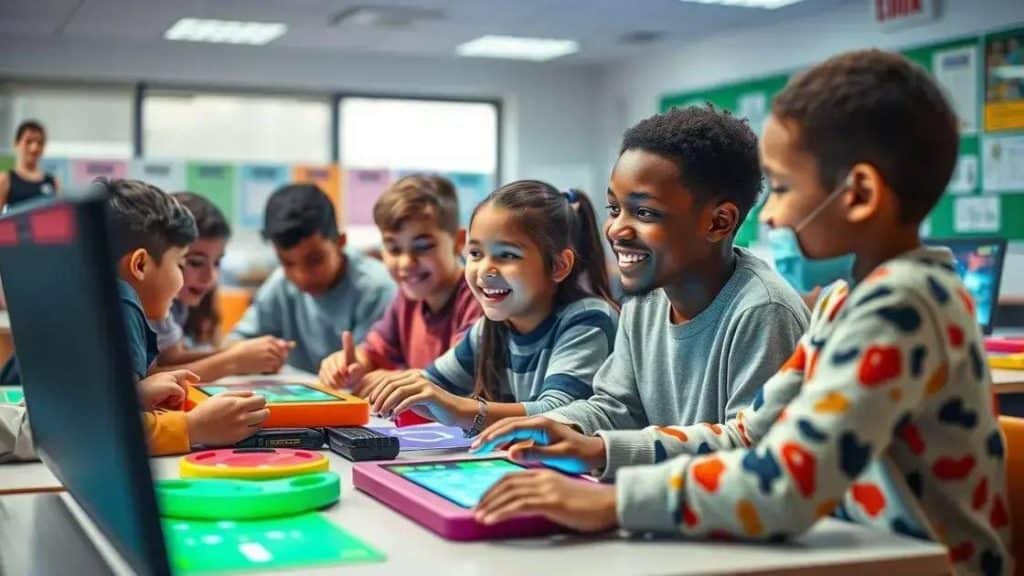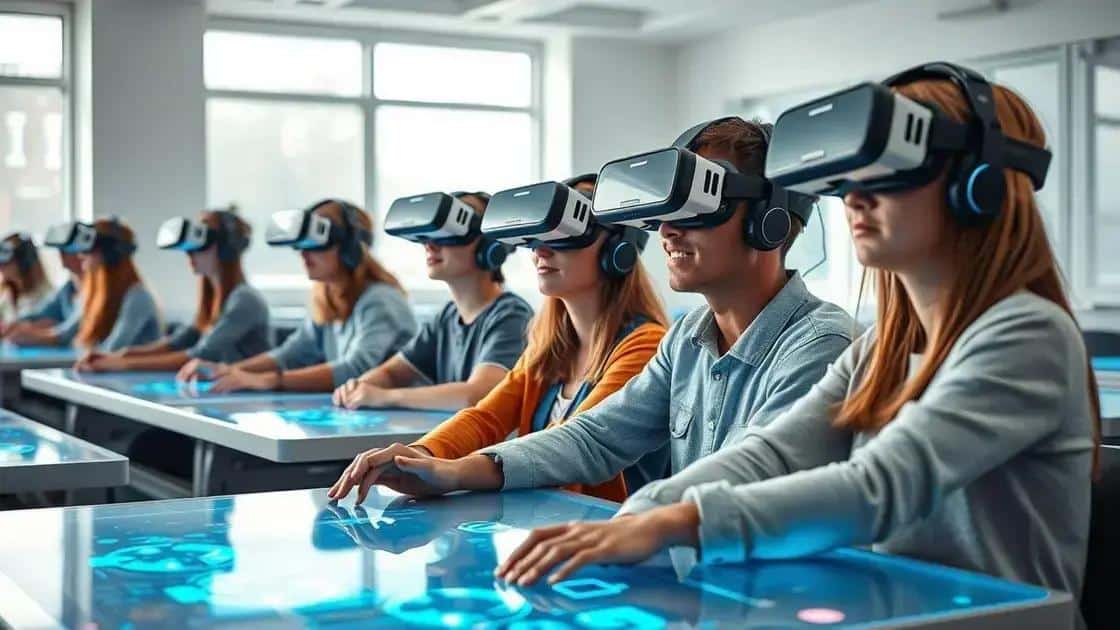Gamified learning platforms trends you should watch

Gamified learning platforms enhance education by integrating game mechanics to boost engagement, retention, and skill development, making learning more enjoyable and effective for students.
Gamified learning platforms trends are making waves in the education sector. Have you noticed how playful elements can make learning more engaging? Let’s dive into what’s changing and how it affects learners.
Understanding gamified learning
Understanding gamified learning is essential in today’s educational landscape. This approach combines elements of game design with traditional learning to create engaging experiences. Why does this matter? Because when students feel involved, they learn better.
What is gamified learning?
Gamified learning integrates game mechanics into non-game contexts, like classrooms. This strategy uses rules, rewards, and competition to motivate students. By presenting educational material in a game-like format, learners stay focused and are more likely to succeed.
Key components of gamified learning
- Points and scores: Students earn points through participation and achievements.
- Levels: Learners progress through stages, building both skill and confidence.
- Badges: Visual milestones recognize accomplishments, similar to trophies.
- Leaderboards: These foster competition and a sense of community.
When used effectively, gamified learning platforms can transform education. Instead of boring lectures, students embark on interactive adventures. They challenge themselves and each other, nurturing enthusiasm.
Research shows that gamification can increase motivation and retention. With features such as instant feedback, learners can identify areas for improvement quickly. This immediate response helps them stay engaged and invested in their education.
Additionally, the social aspect of gamified learning creates a collaborative environment. Students often work in teams, fostering skills like communication and teamwork. These interactions mirror real-world situations, preparing them for future challenges.
As technology advances, gamified learning continues to evolve. New platforms are emerging, offering innovative features that enhance user experience. Staying updated with these trends is crucial for educators wanting to improve their teaching methods.
In summary, understanding gamified learning helps educators create enriching environments. By integrating game elements, they can motivate students and enhance learning outcomes effectively.
Key trends reshaping the landscape

Key trends reshaping the landscape of gamified learning platforms are transforming how education is delivered. As technology continues to evolve, it’s important to explore the latest innovations that enhance learning experiences.
Personalization in learning
One major trend is the shift towards personalized learning paths. Gamified platforms now tailor content to the individual needs of each student. This approach allows for a more engaging experience, as learners can progress at their own pace.
Immersive technology integration
Additionally, the use of immersive technologies such as virtual reality (VR) and augmented reality (AR) is gaining traction. These tools create interactive environments where students can explore and learn in a dynamic way, making lessons memorable.
Data analytics in education
Data analytics is another key player in reshaping the educational landscape. By analyzing student performance data, educators can identify patterns and areas needing improvement. This insight enables more effective teaching strategies.
- Gamified assessments: Interactive quizzes and games assess understanding and retention.
- Real-time feedback: Instant responses keep students engaged and motivated.
- Collaborative learning: Students work together, enhancing community and teamwork skills.
Another trend is the incorporation of social elements. Gamified learning encourages collaboration among students. This social interaction not only improves engagement but also fosters essential skills for future teamwork.
Moreover, mobile accessibility cannot be overlooked. With the rise of smartphones and tablets, learners can access gamified content from anywhere. This flexibility ensures that education is convenient and adaptable to different lifestyles.
As we look to the future, the trends in gamified learning platforms will continue to shape how knowledge is delivered and received. By embracing these changes, educators can create rich, engaging learning environments that cater to diverse student needs.
Benefits of gamified learning platforms
The benefits of gamified learning platforms are substantial and impactful for both students and educators. These platforms engage learners in a fun and interactive way, driving motivation and enhancing educational outcomes.
Increased engagement
One major benefit is increased student engagement. Gamification makes learning less of a chore and more of an adventure. When students compete for points or rewards, they are more likely to participate actively in their learning.
Improved retention rates
Another advantage is improved retention rates. Through interactive gameplay, concepts can be reinforced, making them easier to remember. Studies have shown that players often recall information better when they experience it as part of a game.
- Instant feedback: Students receive immediate responses to quizzes and challenges, helping them understand their strengths and weaknesses.
- Goal-oriented learning: Clear objectives guide students to achieve specific educational milestones.
- Fun environment: Learning becomes enjoyable, reducing anxiety and pressure often felt in traditional settings.
Moreover, gamified platforms support different learning styles. Visual learners benefit from graphic elements, while kinesthetic learners engage through hands-on activities. This versatility ensures that all students can find methods that resonate with them.
Beyond engagement and retention, gamified learning fosters critical skills. Collaboration often arises during team challenges, building teamwork and communication abilities. These skills are invaluable for future educational and career paths.
Data suggests that gamified learning can also lead to increased motivation. Students feel a sense of accomplishment when they reach new levels or earn badges. This feeling can push them to set higher goals and strive for continuous improvement.
Lastly, gamified platforms provide teachers with valuable insights. Through analytics, educators can track progress and identify areas where students struggle. This ability allows them to tailor support, ensuring each learner gets the help they need.
Future predictions for gamification in education

Future predictions for gamification in education point towards exciting advancements that will further enhance the learning experience. As technology continues to innovate, we can expect significant changes that impact both students and educators.
Increased integration of AI
One promising trend is the increased integration of artificial intelligence (AI) in gamified platforms. AI can analyze student behavior and learning patterns to create personalized gamified experiences. This means that learning paths will adapt in real-time, tailoring challenges to each student’s unique needs.
Expansion of immersive learning environments
Additionally, immersive learning environments will likely become more prevalent. With technologies like virtual reality (VR) and augmented reality (AR), students will have the opportunity to engage in realistic scenarios. This could transform how subjects like history or science are taught, making lessons interactive and unforgettable.
- Enhanced social interaction: Future platforms may foster greater collaboration among students through multiplayer educational games.
- Gamification of remote learning: As online education grows, gamification will help maintain engagement in virtual classrooms.
- Focus on soft skills: Future gamified learning may emphasize skills like communication and critical thinking through collaborative tasks.
Moreover, education will likely shift towards a more competency-based model. Students will advance through levels based on demonstrated mastery rather than time spent in class. This approach aligns perfectly with gamified methods, where achievements drive progression.
Another aspect to consider is the potential for gamification in lifelong learning. As individuals seek to upskill or change careers, gamified platforms can provide enjoyable ways to acquire new knowledge. This shift will make learning a continuous, engaging journey.
Furthermore, there will be an increasing emphasis on analytics and feedback. Educators will use data to refine gamified experiences, ensuring they meet learning goals effectively. This data-driven approach will help both students and teachers track progress over time.
As we look to the future, the predictions for the role of gamification in education are bright. Innovations will foster environments where learners thrive, bridging gaps and making education more accessible and enjoyable for all.
FAQ – Frequently Asked Questions about Gamified Learning Platforms
What are gamified learning platforms?
Gamified learning platforms incorporate game design elements into educational settings to enhance engagement and motivation in students.
How do gamified platforms increase student engagement?
These platforms make learning interactive and fun, encouraging students to participate more actively through rewards, competition, and challenges.
Can gamified learning improve retention rates?
Yes, gamification helps reinforce concepts by making learning experiences more memorable, leading to better information retention.
What future trends can we expect in gamified education?
Future trends include increased integration of AI for personalization, more immersive learning environments with VR, and a greater focus on developing soft skills like teamwork.





